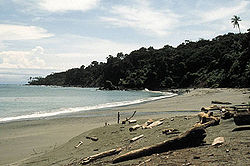- Gorgona, Colombia
-
Gorgona is a Colombian island in the Pacific Ocean situated about 50 km off the Colombian Pacific coast and part of the municipality of Guapi in the Department of Cauca. The island is about 9 km long (5.6 mi) and 2.5 km (1.6 mi) wide, with a maximum height of 338 m (1,110 ft); with an area of 10 square miles (26 km²). It is surrounded by numerous smaller stacks and keys. Gorgona is separated from the continent by a 270 meter (885 ft) deep underwater depression. The island functioned as a prison (similar to Alcatraz Island) until 1985 when it was turned into a National Natural Reservation Park noted for a large number of endemic species resulting from its isolation from the American continent.
Contents
History
Before America was discovered, Gorgona was first inhabited, by people possibly associated with the Tumaco, Tolita culture. The indigenous Kuna or Cuna of Urabá (Colombia) and San Blas (Panama), have the tradition of being the first settlers of the island. They left archeological remains that are at least 3300 years old. Spanish conquerors first visited Gorgona in 1527 when Francisco Pizarro, in his third expedition to Peru, discovered the island. Pizarro and thirteen of his men remained for seven months in Gorgona waiting for the arrival of provisions.
In the period after the Spanish Conquest, the Cacique Yundigua, lived in the island. He probably was a member of the indigenous group Sindagua, a tribe that lived between Nariño and Cauca.
Gorgona housed a state high security prison from the 1950s. Convicts were dissuaded from escaping by the poisonous snakes in the interior of the island and the sharks patrolling the 30 km to the mainland. The penal colony was closed in 1984 and the last prisoners were transferred to Colombia mainland. The former jail buildings now have been covered by dense vegetation, but a portion can still be seen. The island was established as Gorgona Island National Park in 1985, in order to preserve its endemic species, the richly varied wildlife of the sub-tropical forest and the coral reefs offshore. The park covers an area of 120,000 acres (490 km2).
Gorgona has no permanent population, except staff involved in the administration and preservation of the National Park. The island has been developed as an Ecotourism center with lodgings and a restaurant. Visitors need previous permission to come to the island. Gorgona can host around 80 visitors at one given time. Camping is not allowed, and the only housing available is the one provided by the park administration in El Poblado, the only settlement area of the island. It is a very quiet place, built facing the ocean. Each group is assigned one guide upon arrival to accompany the tourists wherever the group wishes to go. Since Gorgona is a tropical environment known for its poisonous snakes, visitors are not allowed to set foot anywhere unaccompanied and not wearing boots, except for the beach in front of the rooms.
Environment
Weather
The island has an average temperature of 27 degrees Celsius. With an average 98% humidity, intense rainfalls and misty days are frequent; Gorgona is said to have its own cloud, always looming on its mountaintop. It rains all year around, but even more so in September and October. The island has at least twenty-five permanent fresh-water streams. In less than half a kilometer in the beach called La Camaronera ten creeks reach the sand. The shores of Gorgona are predominantly steep plunging cliffs, minor sandy, and shingle beaches supplied on its eastern side, by coral reef detritus. A dense very humid jungle covers the center of the island.
Fauna
The island is best known for the yearly visit humpback whales pay its shores from August to October accompanied by their newborn. Gorgona is also a snorkeling and diving paradise. The islands dense rainforest has been isolated for thousands of years from the mainland, and gives shelter to some unique species like the endemic Blue Anole, which is the only all-blue anole lizard in the world.
Gorgona is famous for its snakes. There are three venomous snakes including the much-feared terciopelo Bothrops atrox and two species of Coral snake. Many non-venomous snakes such as the Boa constrictor and Oxybelis aeneus also inhabit the island. Two introduced species that are very visible on the island are the Basiliscus galeritus and the White-headed Capuchin.
The Brown Booby breeding population nesting in Gorgona NNP is small, but is the most important breeding territory for Sula leucogaster etesiaca in the world. The population of 150 pairs registered in 2002 exceeds the number of individuals in other regional localities.[1][2] Brown Boobies in Gorgona NNP breed asynchronously; on the same date Ospina-Alvarez recorded eggs, chicks in early or youthful stages, and fledged chicks. The calculated accumulative RS (17.3%) included more than 95% of all pairs breeding in 2002 - 2003, but this may change to year after year.[1]
References
- ^ a b Ospina-Alvarez, A. 2008. Coloniality of Brown booby (Sula leucogaster) in Gorgona National Natural Park, Eatern Tropical Pacific. Onitología Neotropical 19: 517–529
- ^ Naranjo, L. G., A. Aparicio, & P. E. Falk. 2001. Evaluación de áreas importantes para aves marinas y playeras en el litoral Pacífico Colombiano. Fondo FEN, Cali, Colombia.
External links
 Media related to Gorgona Island at Wikimedia CommonsCategories:
Media related to Gorgona Island at Wikimedia CommonsCategories:- Pacific islands of Colombia
- National parks of Colombia
Wikimedia Foundation. 2010.





